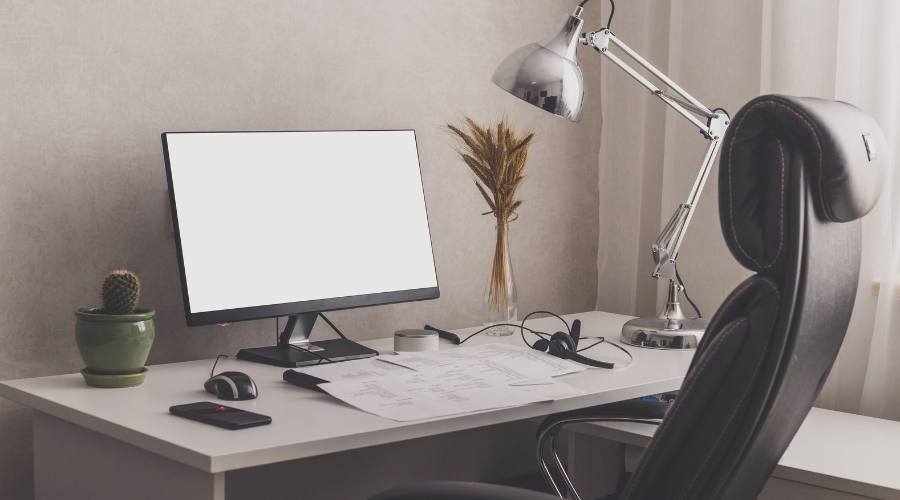Having a comfortable and efficient home office has become essential for many professionals.
A well-organized workspace not only increases productivity but also contributes to overall well-being.
This blog post will provide you with 15 best home office setup ideas to help you create the perfect workspace tailored to your needs and preferences.
1. Ergonomic Furniture
A crucial aspect of any home office setup is investing in ergonomic furniture.
Your comfort and physical health directly impact your productivity, so it’s essential to choose the right pieces for your workspace.
Importance of ergonomic chairs
Lumbar support
A chair with proper lumbar support helps maintain the natural curve of your spine and prevents slouching, reducing the risk of developing back pain.
Look for chairs with adjustable lumbar support to suit your specific needs.
Adjustability
An ergonomic chair should have various adjustable features, such as seat height, armrests, and tilt mechanism.
This customization ensures the chair fits your body and supports the correct posture throughout your workday.
Height-adjustable desks
Standing desks
Standing desks allow you to switch between sitting and standing positions effortlessly.
This flexibility helps reduce the negative effects of prolonged sitting, such as back pain and decreased circulation.
Benefits of alternating between sitting and standing
Integrating standing breaks into your work routine can boost your energy levels, improve focus, and promote better posture.
Moreover, it helps burn more calories and reduce the risk of developing chronic health conditions.
2. Optimized Workspace Layout
A well-planned office layout can significantly enhance your workflow and overall comfort. Consider these factors when organizing your workspace:
Desk positioning
Natural lighting
Place your desk near a window to take advantage of natural light, which can improve your mood, reduce eye strain, and lower energy costs. Make sure to position your monitor perpendicular to the window to minimize glare.
Avoiding glare
To further reduce glare, use blinds or curtains to control the amount of sunlight entering your workspace. This adjustment will also help regulate the room’s temperature, ensuring a comfortable environment.
Desk organization
Cable management
Untidy cables can make your workspace look cluttered and cause accidents. Use cable organizers, such as cable clips or cord sleeves, to keep cords neat and organized.
Storage Solutions
Opt for storage options like desk drawers, shelves, or desktop organizers to keep frequently used items within reach and maintain a clutter-free workspace.
3. Personalization
Adding personal touches to your home office can make it more inviting and enjoyable.
Personal touches
Framed photos
Incorporate framed photos of loved ones or memorable moments to create a warm and comforting atmosphere.
Artwork
Choose artwork that reflects your personality, interests, or inspiration to make your workspace uniquely yours.
Incorporating plants
Benefits of greenery
Plants can improve air quality, reduce stress, and enhance the overall aesthetic of your office. Research shows that adding greenery to your workspace can increase productivity and focus.
Low-maintenance plant options
Consider low-maintenance plants like snake plants, pothos, or ZZ plants to add a touch of nature without requiring too much attention.
4. Technology Upgrades
Investing in the right technology is crucial for an efficient home office.
Choosing the right computer
Laptop vs. desktop
Laptops offer flexibility and portability, while desktops generally provide better performance and larger screens. Choose the option that best suits your work requirements and personal preferences.
Hardware considerations
Consider the processing power, RAM, and storage capacity needed for your work tasks. Investing in a high-quality computer can greatly enhance your productivity and overall work experience.
Monitors
Multiple monitor setups
Using multiple monitors can significantly increase your efficiency, especially when multitasking. You can dedicate one screen for communication, another for research, and a third for your primary work tasks.
Screen size and resolution
Choose monitors with appropriate screen sizes and resolutions that suit your work needs.
High-resolution monitors can reduce eye strain and provide a better visual experience.
5. Accessories and Peripherals
Selecting the right accessories and peripherals can improve your comfort and productivity.
Keyboards and Mice
Ergonomic designs
Ergonomic keyboards and mice can reduce the risk of developing wrist pain or repetitive strain injuries. Look for options with appropriate support and adjustability.
Wireless options
Wireless keyboards and mice can help declutter your workspace and provide more flexibility in positioning your peripherals.
Headphones and speakers
Noise-cancelling options
Noise-cancelling headphones can help block out distractions, making it easier to concentrate on your work.
Bluetooth connectivity
Bluetooth headphones and speakers can reduce cable clutter and provide seamless connectivity with your devices.
6. Lighting
Proper lighting is essential to create a comfortable and functional workspace.
Task lighting
Desk lamps
Desk lamps provide focused lighting for specific tasks, such as reading or writing. Look for lamps with adjustable brightness and color temperature settings to suit your preferences.
Adjustable brightness and color temperature
Adjustable brightness and color temperature settings can help reduce eye strain and create a more comfortable work environment.
Ambient lighting
Floor lamps
Floor lamps can create a warm and inviting atmosphere, making your home office feel more comfortable.
Wall sconces
Wall sconces provide soft, indirect lighting that can help reduce shadows and create a cozy ambiance.
7. Acoustics and Soundproofing
Creating a quiet work environment is crucial for concentration and productivity.
Sound-absorbing materials
Curtains and rugs
Thick curtains and rugs can help absorb sound and reduce echoes in your workspace.
Acoustic panels
Acoustic panels can be mounted on walls or ceilings to absorb sound and improve your home office’s overall acoustics.
White noise machines
Benefits of white noise
White noise machines produce consistent ambient sounds that can mask distracting noises, helping you focus on your work.
Different types of machines
Choose from various white noise machines with different sound options, such as nature sounds or simple white noise, to find the best fit for your preferences.
8. Creating a Dedicated Workspace
Establishing a dedicated workspace can help separate your work life from your personal life.
Separating work from home life
Room dividers
Use room dividers to create a dedicated office space within a larger room, providing a visual and physical separation between work and personal areas.
Dedicated office rooms
If possible, set up your home office in a separate room, allowing for complete isolation from household distractions.
Establishing boundaries
Communication with family members
Clearly communicate your work schedule and boundaries with family members to minimize interruptions and maintain a healthy work-life balance.
Time management techniques
Implement time management techniques, such as the Pomodoro Technique or time-blocking, to stay focused and productive during your work hours.
9. Color Psychology
The color of your workspace can have a significant impact on your productivity and mood.
Impact of color on productivity
Different colors can evoke various emotions and affect your energy levels. Choose colors that inspire and motivate you to create a productive work environment.
Choosing the right color scheme
Cool colors
Cool colors, such as blues and greens, can create a calming and focused atmosphere. They are ideal for reducing stress and promoting concentration.
Warm colors
Warm colors, like yellows and oranges, can stimulate creativity and boost energy levels. They can be especially helpful for creative professionals or those who need a little extra motivation during the day.
10. Comfortable Seating Areas
Creating additional seating areas in your home office can promote relaxation and help alleviate the physical strain of sitting for extended periods.
Lounge chairs or bean bags
Add lounge chairs or bean bags to your office for a comfortable place to relax during breaks or brainstorm ideas.
Benefits of taking breaks and changing positions
Taking regular breaks and changing positions can help reduce mental fatigue and physical discomfort, ultimately leading to increased productivity and a healthier work routine.
11. Effective Storage Solutions
Efficient storage solutions can keep your workspace organized and clutter-free.
Filing cabinets
Filing cabinets offer a practical and accessible way to store important documents, ensuring your workspace remains tidy and well-organized.
Shelving and bookcases
Shelves and bookcases provide additional storage for books, decorative items, and office supplies, keeping your workspace functional and visually appealing.
Desk organizers
Desk organizers help you maintain a clean and orderly work surface, making it easier to find what you need and focus on your tasks.
12. Air Quality and Temperature
Maintaining good air quality and a comfortable temperature in your home office is essential for a productive work environment.
Ventilation
Opening windows
Open windows periodically to allow fresh air to circulate, improving air quality and reducing indoor pollutants.
Air purifiers
Consider using an air purifier to filter out allergens, dust, and other contaminants, creating a healthier workspace.
Temperature control
Fans
Use fans to improve air circulation and maintain a comfortable temperature during warm months.
Space heaters
Portable space heaters can help you regulate the temperature in your home office during colder months, ensuring a comfortable work environment.
13. Minimizing Distractions
Reducing distractions in your home office can significantly improve your focus and productivity.
Screen management
Focus-enhancing apps
Utilize focus-enhancing apps, such as Freedom or Focus@Will, to block distractions on your devices and maintain concentration on your work.
Organizing desktops and notifications
Organize your desktop and customize your notifications to minimize distractions and promote a more focused work environment.
Designated break areas
Separate spaces for relaxation
Establish separate areas for relaxation and breaks to ensure your workspace remains a dedicated area for productivity.
Establishing routines
Create a routine that includes designated break times to maintain a consistent work schedule and prevent burnout.
Conclusion
In conclusion, a comfortable and efficient home office is essential for maximizing productivity and maintaining overall well-being.








